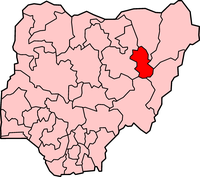Gombe state is under the NorthEast geopolitical zone of Nigeria and shares boundaries with Adamawa, Bauchi, Yobe, Borno and Taraba states. The capital of the state is Gombe while other prominent towns include Bajoga, Biliri, Kaltungo, Kumo and Dukku.
The tribes found in Gombe state include the Fulani, Tangale, Tera, Waja, Bolewa, Hausa, Kumo, Jukun, Per/Shonge, Tula, Cham, Lugunda, Dadiya, Banbuka and Kanuri. Gombe state boasts 11 Local Government areas which include Akko, Balanga, Nafada, Gombe, Biliri, Kaltungo, Yamaltu- Deba, Kwami, Dukku, Funakaye and Shongom LGAs and 14 emirates also referred to as Chiefdoms. The population of Gombe state is estimated at 2, 353, 879 inhabitants with Islam as the most widely practiced religion. Festivals held in Gombe state include the Kamo cultural festival, Pissi Tangle festival, Kaltungo festival, Chugothe, Kuram, Yeku, Bashari, Yiliri, and the Ilar-Zhare festivals.
Popular landmarks in Gombe state include the Gombe Lawanti International Airport, the Mbormi battle ground, and the palace of the Emir of Gombe. Tertiary Institutions in Gombe state include the Federal University Kashere, Federal College of Education (Technical) Gombe, Gombe state University Tudun Wada, National Open University of Nigeria, College of Administrative and Business studies Kumo, Gombe state College of Education Biliri, College of Nursing and Midwifery Dukku, and the Gombe state Polytechnic Bajoga. Health facilities found in Gombe state include the Idi Children and Women's Hospital, Gombe Specialist Hospital, General Hospital Kashere, Gombe state UniversityTeaching Hospital, Kaltungo General Hospital, Federal Teaching Hospital Gombe, and the Kumo General Hospital. Tourist destinations in Gombe state include the Tomb of Bubayero, Bima Hill, Kilang Hill, Tula Plateau, Bulok warm spring, Bage hills, Kanawa forest, Tula Cave, and the Dadin kowa Dam.
The Governor of Gombe State is Ibrahim Hassan Dankwambo.
Jewel of Excellence
Gombe state has a total area of 18,768 km squared with annual temperature at 37 degrees centigrade. The topography is largely mountainous and flat open with average humidity pegged at 44 percent.
There are two major seasons in Gombe state which are the rainy season which runs from April to October with total annual precipitation at 1200 mm and the dry season which runs from November to March.
The total area of Gombe state measures about 20,265 km squared with the dominant soil types being the loamy and the sandyloam with appreciable amount of clay found in some parts of the state.
Gombe State is both an agricultural and commercial state. Crops cultivated in Gombe state include grains such as rice, beans, millet, and maize while there is also an appreciable level of animal rearing.
Trade is also a prominent feature of the economic life of Gombe state with popular markets such as the Gombe Main market, Kindiyo market Balanga, Kuri Cattle market Yamaltu Deba, and the Tudun Hatsi grains market attracting thousands of buyers and sellers on a daily basis.
A number of mineral resources are found in Gombe state and these include clay, limestone, uranium,coal, diatomite, graphite, calcite, mica, gemstone, and gypsum.
Gombe state was formed from the old Bauchi state on the 1st of October 1996 with Group Capt. Joseph Orji as the pioneer administrator from October 1996 - august 1998.
The full list of past and present governors/ administrators of Gombe state include
Joseph Orji - 1996-1998
Mohammed Bawa- 1998-1999
Abubakar Habu Hashidu - 1999-2003
Danjuma Goje - 2003- 2011
Ibrahim Hassan Dankwambo- 2011 to date.
4 based on 0 reviews

Find and explore some of the best businesses in Gombe State.
© 2025 Manpower Nigeria. All rights reserved.